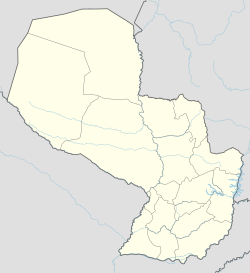Itaugua
| Itauguá | |
|---|---|
| City | |
| Itauguá | |
| Coordinates: 25°23′S 57°20′W / 25.383°S 57.333°WCoordinates: 25°23′S 57°20′W / 25.383°S 57.333°W | |
| Country | Paraguay |
| Department | Central |
| Founded | June 27, 1728 |
| Founded by | Martín de Barúa |
| Government | |
| • Intendente Municipal | Miguel Angel Meza Acosta |
| Area | |
| • Total | 122 km2 (47 sq mi) |
| Elevation | 170 m (560 ft) |
| Population (2016) | |
| • Total | 100,456 |
| • Density | 1,090.84/km2 (2,825.3/sq mi) |
| Time zone | -4 Gmt (UTC-4) |
| Postal code | 2740 |
| Area code(s) | (595) (294) |
| Climate | Cfa |
Itauguá (Spanish pronunciation: [itauˈɣwa]) is a city of the Central Department, Paraguay. Founded in 1728, it's known by its peculiar art of the ñandutí and its music.
The San Rafael Museum shows various objects from the Colonial Age.
The National Hospital, one of the most important health institutions, is located in Itauguá.
Itauguá is about 30 kilometers away from Asunción. It was founded by Governor Martín de Barúa on June 27, 1728.
The architecture of the Colonial Age is still visible in the center of the city.
Its name is related to the Ytay stream, that flows through the land. So, "ita", which means "stone" in the Guaraní language, plus the suffix "gua", which indicates "belonging in Guaraní language".
Actually, Itauguá is denominated as the "City of the Ñandutí" because of its main artesian work, known by the similarity to the spider webs.
One of the most important cultural expressions is the "Ñandutí Festival" which has been attracting large audiences annually for over 30 years. The first edition was in June 1970. Great artists who have participated in the festival include Juan Cancio Barreto, Grupo Generación, Quemil Yambay, Vocal Dos, Oscar Pérez and his band, also the famous band of Juan Carlos Oviedo and the Acuña Brothers.
The city possesses a supply of drinkable water across Meetings of Environmental Reparation and does not possess sanitary sewer. It possesses, in addition, the polysport "Dr. Nicolás Léoz"
Itauguá has 89,449 inhabitants, from which 44,997 are males and 44,451 females, according to the General Office of Statistics, Polls and Census.
Among the touristic attractions are the hills Patiño and Cerrito, the Virgen del Rosario Church, the San Rafael Museum, and the colonial houses built during the time of the former dictator Gaspar Rodríguez de Francia.
The climate is pretty fresh. The warm weather predominates with high temperatures during the spring and the summer.
Itauguá is characterized especially by the manufacture and sale of textiles of Ñandutí. This product is exported to many foreign countries. The tourists always show great interest in the ñandutí, considering it as an everlasting product which easily conquers international markets.
...
Wikipedia

